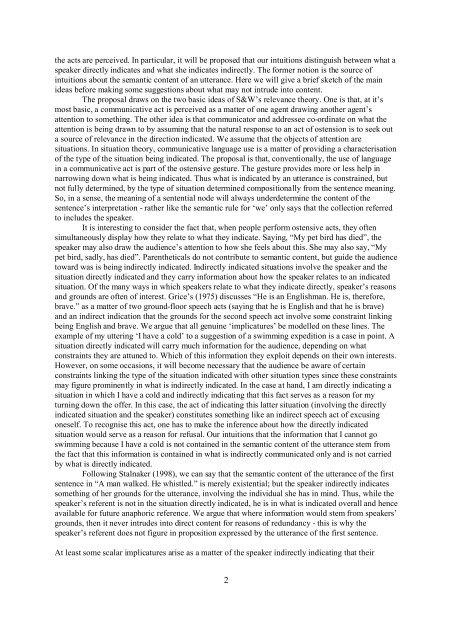SemPrag03.Progr.pdf - Institut für Linguistik/Germanistik - Universität ...
SemPrag03.Progr.pdf - Institut für Linguistik/Germanistik - Universität ...
SemPrag03.Progr.pdf - Institut für Linguistik/Germanistik - Universität ...
Create successful ePaper yourself
Turn your PDF publications into a flip-book with our unique Google optimized e-Paper software.
the acts are perceived. In particular, it will be proposed that our intuitions distinguish between what a<br />
speaker directly indicates and what she indicates indirectly. The former notion is the source of<br />
intuitions about the semantic content of an utterance. Here we will give a brief sketch of the main<br />
ideas before making some suggestions about what may not intrude into content.<br />
The proposal draws on the two basic ideas of S&W’s relevance theory. One is that, at it’s<br />
most basic, a communicative act is perceived as a matter of one agent drawing another agent’s<br />
attention to something. The other idea is that communicator and addressee co-ordinate on what the<br />
attention is being drawn to by assuming that the natural response to an act of ostension is to seek out<br />
a source of relevance in the direction indicated. We assume that the objects of attention are<br />
situations. In situation theory, communicative language use is a matter of providing a characterisation<br />
of the type of the situation being indicated. The proposal is that, conventionally, the use of language<br />
in a communicative act is part of the ostensive gesture. The gesture provides more or less help in<br />
narrowing down what is being indicated. Thus what is indicated by an utterance is constrained, but<br />
not fully determined, by the type of situation determined compositionally from the sentence meaning.<br />
So, in a sense, the meaning of a sentential node will always underdetermine the content of the<br />
sentence’s interpretation - rather like the semantic rule for ‘we’ only says that the collection referred<br />
to includes the speaker.<br />
It is interesting to consider the fact that, when people perform ostensive acts, they often<br />
simultaneously display how they relate to what they indicate. Saying, “My pet bird has died”, the<br />
speaker may also draw the audience’s attention to how she feels about this. She may also say, “My<br />
pet bird, sadly, has died”. Parentheticals do not contribute to semantic content, but guide the audience<br />
toward was is being indirectly indicated. Indirectly indicated situations involve the speaker and the<br />
situation directly indicated and they carry information about how the speaker relates to an indicated<br />
situation. Of the many ways in which speakers relate to what they indicate directly, speaker’s reasons<br />
and grounds are often of interest. Grice’s (1975) discusses “He is an Englishman. He is, therefore,<br />
brave.” as a matter of two ground-floor speech acts (saying that he is English and that he is brave)<br />
and an indirect indication that the grounds for the second speech act involve some constraint linking<br />
being English and brave. We argue that all genuine ‘implicatures’ be modelled on these lines. The<br />
example of my uttering ‘I have a cold’ to a suggestion of a swimming expedition is a case in point. A<br />
situation directly indicated will carry much information for the audience, depending on what<br />
constraints they are attuned to. Which of this information they exploit depends on their own interests.<br />
However, on some occasions, it will become necessary that the audience be aware of certain<br />
constraints linking the type of the situation indicated with other situation types since these constraints<br />
may figure prominently in what is indirectly indicated. In the case at hand, I am directly indicating a<br />
situation in which I have a cold and indirectly indicating that this fact serves as a reason for my<br />
turning down the offer. In this case, the act of indicating this latter situation (involving the directly<br />
indicated situation and the speaker) constitutes something like an indirect speech act of excusing<br />
oneself. To recognise this act, one has to make the inference about how the directly indicated<br />
situation would serve as a reason for refusal. Our intuitions that the information that I cannot go<br />
swimming because I have a cold is not contained in the semantic content of the utterance stem from<br />
the fact that this information is contained in what is indirectly communicated only and is not carried<br />
by what is directly indicated.<br />
Following Stalnaker (1998), we can say that the semantic content of the utterance of the first<br />
sentence in “A man walked. He whistled.” is merely existential; but the speaker indirectly indicates<br />
something of her grounds for the utterance, involving the individual she has in mind. Thus, while the<br />
speaker’s referent is not in the situation directly indicated, he is in what is indicated overall and hence<br />
available for future anaphoric reference. We argue that where information would stem from speakers’<br />
grounds, then it never intrudes into direct content for reasons of redundancy - this is why the<br />
speaker’s referent does not figure in proposition expressed by the utterance of the first sentence.<br />
At least some scalar implicatures arise as a matter of the speaker indirectly indicating that their<br />
2

















